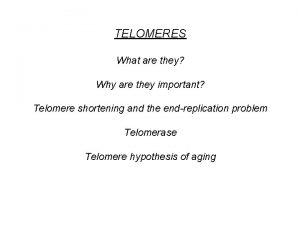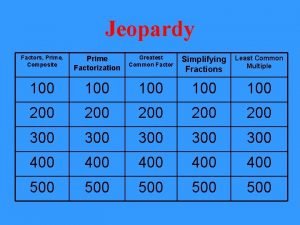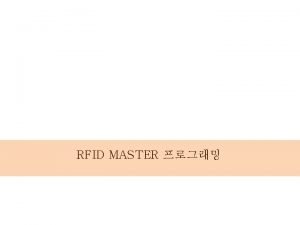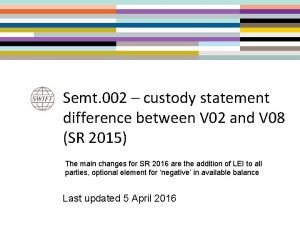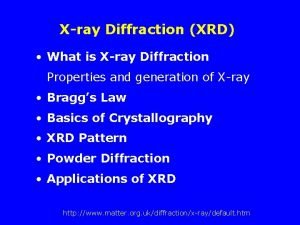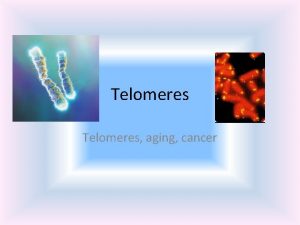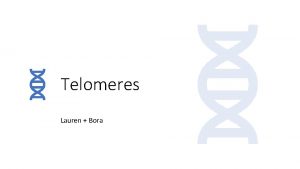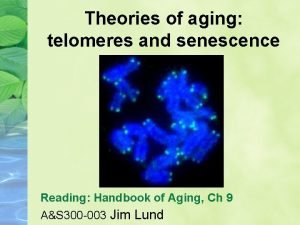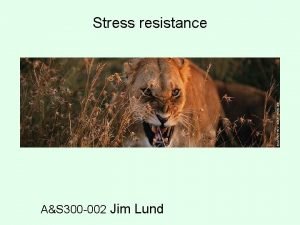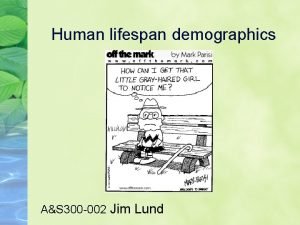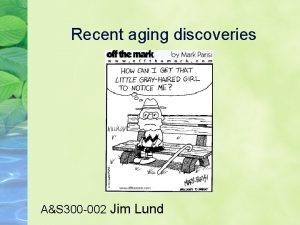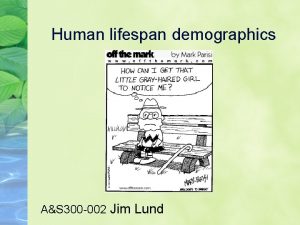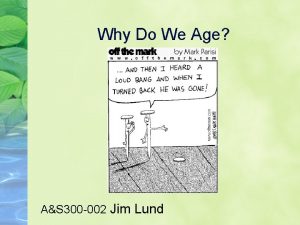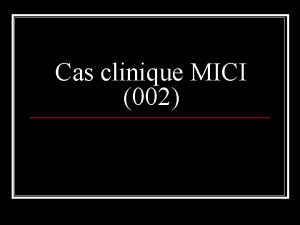Telomeres and senescence II AS 300 002 Jim























- Slides: 23

Telomeres and senescence II A&S 300 -002 Jim Lund

Telomeres in mice Lab strains of mice have very long telomeres. 30 -40 kb telomeres. Tert knock-out mice: Normal for four generations as their telomeres shorten, Premature aging phenotypes present in the 5 th and generation.

Telomeres: Ageing hard or hardly ageing? (Nature 398, 191 -193, 1999) Table 1. Aging syndromes in mouse and man

Telomeres are one of the blocks to cancer formation The limited replicative potential of somatic cells blocks runaway cell division. Population doublings is an evolutionary trade off between cell renewal and cancer susceptibility.

Telomerase and Senescence In most somatic tissues, telomerase is expressed at very low levels or not at all -- as cells divide, telomeres shorten Short telomeres signal cells to senesce (stop dividing)

Telomerase and Cancer The presence of telomerase in cancer cells allows them to maintain telomere length while they proliferate

Telomerase and Cancer Will turning off telomerase in cancer cells cause them to senesce and thereby stop progression of the disease? Works in some cases. Studies in an important model system, Telomerase deficient mice indicate that it will probably depend on the type of tumor.

Short telomeres cause growth arrest via a checkpoint Sensed as DNA damage by the p 53 checkpoint Stops Cell Division If the cells of a particular tumor still have p 53, this works

Tumor cells often lose p 53 Sensed as DNA damage by the p 53 checkpoint Cell division continues without telomeres leading to chromosomal rearrangements This genomic instability can promote tumorigenesis

Telomeres and cancer

Telomeres shorten with age (Harley, 1990)

Telomeres shorten with age HSC 172 (fetal sample) F 001 71 yr. old (Harley, 1990)

Telomere variation Telomere lengths vary -- from cell to cell, from tissue to tissue. 2 X difference often observed. Only one telomere in a cells needs to shorten to the critical point for senescence to be triggered. Hard to measure experimentally.

Telomere loss rate From a mechanistic basis, loss will be 812 bp per replication cycle. 10 bp x 50 doublings = 500 bp loss. In vivo, mean telomere length decreases by about 15 bp per year. 15 bp x 80 yr = 1200 bp loss. (Harley, 1990)

Telomere loss rate In typical cell culture conditions, telomeres lose 50 - 90 bp per doubling. 50 - 90 bp x 50 doublings = 2. 5 - 4. 5 kb loss. Telomere loss rate is affected by oxidative stress: Under high oxygen partial pressure (double normal for cell culture), telomere loss rate is 5 X higher. 500 bp x 4 doublings = 2, 000 bp loss Cells stop dividing when telomeres shorten to 4 kb after a few doublings. (von Zglinicki et al. , 1995)

Telomere damage a source of shortening Telomere loss rate is affected by oxidative stress: In cell culture, telomeres shorten faster under high oxygen partial pressure, low under low oxygen partial pressure. In stationary phase cell culture, put the culture under oxidative stress: Can detect DNA damage at telomeres, DNA nicks (single strand breaks). DNA repair at telomeres seems poorer than for other DNA.

Senescence morphology Senescent cells become flattened, enlarged and have increased -galactosidase activity Increased size of nucleus and nucleoli Increased number of multinucleated cells Increased number of lysosomes, Golgi and cytoplasmic microfilaments

Senescent human fibroblasts 'Young' Presenescent 'Aged' Senescent

Cellular Senescence: Arrests Cell Growth In response to Potential Cancer-Causing Events Chromatin Instability Irreversible arrest of cell growth DNA Damage Stress/damage Signals Oncogenes Short/dysfunctional telomeres

Senescent/'aged' cells: Many characteristics change Irreversible Growth Arrest Resistance to Apoptosis Altered Function/Gene Expression

Senescence is a progressive process Fibroblasts grown in culture for 55 population doublings, about 300 days. Then they were maintained in culture an additional 300 days. • Cell types: • I-III are mitotic. • IV-VI are post-mitotic and differ in size. Bayreuther et al. , 1992 a, b • VII apoptotic or transformed.

Senescence is a progressive process Fibroblasts samples from people of different ages. • Cell types: • I-III are mitotic. • IV-VI are post-mitotic. Bayreuther et al. , 1992 a, b

Telomere shortening: not universal Some animals do not undergo telomere shortening but still age: Rabbits and hares (Forsyth et al. , 2005). Some invertebrates: Drosophila melanogaster (don’t have telomeres). Podospora (a filamentous fungus) Senescence can happen in the absence of telomere shortening, for example in Hutchinson-Gilford progeria. Senescence also occurs in non-dividing cells (ie. , neurons).
